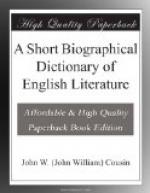ROWLEY, WILLIAM (1585?-1642?).—Dramatist, was an actor in the Queen’s Company 1610. He collaborated with Middleton in A Fair Quarrel and The Changeling, and in others with Dekker, Webster, etc., and wrote unassisted A New Wonder, A Match at Midnight, A Shoemaker, a Gentleman, and several others; also a picture of life in London called A Search for Money. R. was vigorous and humorous, but his verse lacked sweetness and smoothness.
RUDDIMAN, THOMAS (1674-1757).—Grammarian, b. in Banffshire, and ed. at King’s Coll., Aberdeen, obtained a position in the Advocates’ Library in Edin., of which in 1730 he became Librarian. In 1714 he pub. his Rudiments of the Latin Tongue, which was for long the recognised Latin grammar in the schools of Scotland. He was made printer to the Univ. in 1728. R., who was one of the greatest of Scottish Latinists, produced an ed. of the works of George Buchanan, and an ed. of Livy said to be “immaculate.” He also reprinted, with notes, Gavin Douglas’s version of the AEneid.
RUSKIN, JOHN (1819-1900).—Writer on art, economics, and sociology, was b. in London, the s. of a wealthy wine merchant, a Scotsman. Brought up under intellectually and morally bracing Puritan influences, his education was mainly private until he went to Oxf. in 1836; he remained until 1840, when a serious illness interrupted his studies, and led to a six months’ visit to Italy. On his return in 1842 he took his degree. In 1840 he had made the acquaintance of Turner, and this, together with a visit to Venice, constituted a turning point in his life. In 1843 appeared the first vol. of Modern Painters, the object of which was to insist upon the superiority in landscape of the moderns, and especially of Turner, to all the ancient masters. The earnestness and originality of the author and the splendour of the style at once called attention to the work which, however, awakened a chorus of protest from the adherents of the ancients. A second vol. appeared in 1846, the third and fourth in 1856, and the fifth in 1860. Meanwhile he had pub. The Seven Lamps of Architecture (1849), The Stones of Venice (1851-53), perhaps his greatest work, Lectures on Architecture and Painting (1854), Elements of Drawing (1856), and Elements of Perspective (1859). During the 17 years between the publication of the first and the last vols. of Modern Painters his views alike on religion and art had become profoundly modified, and the necessity of a radical change in the moral and intellectual attitude of the age towards religion, art, and economics in their bearing upon life and social conditions had become his ruling idea. He now assumed the role of the prophet as Carlyle, by whose teaching he was profoundly influenced, had done, and the rest of his life was spent in the endeavour




